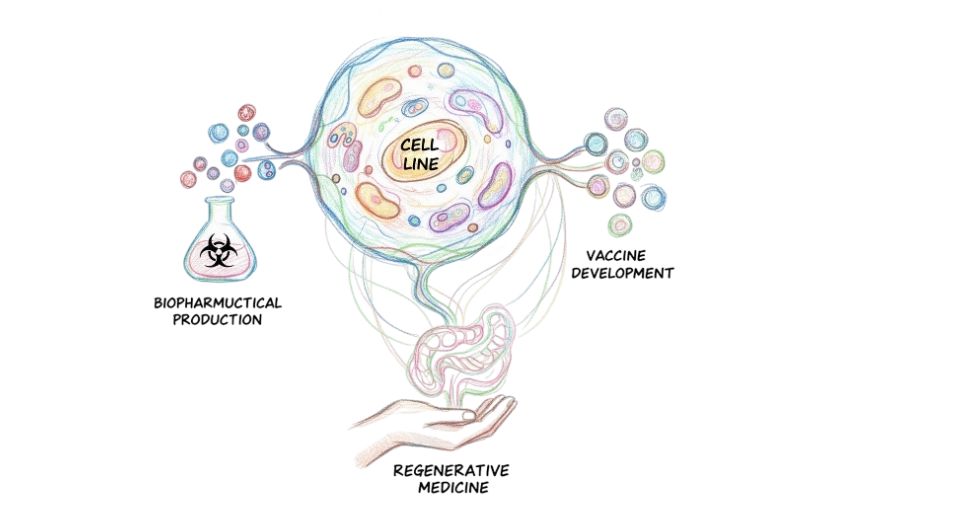
Oct 29, 2025

The global cell line and membrane market offered by Metastat Insight describes how cellular innovation is transforming medicine, biotechnology, and materials science. All medical therapy, diagnostic progress, and pharma innovation today rely on stable cellular systems and membrane technologies that provide reproducibility, precision, and scalability. To manufacture biopharmaceuticals to studying genetic responses, such devices are the unseen fabric of research and manufacturing. As biopharmaceuticals call for safer biologics, customized therapies, and greener bioprocessing, cellular infrastructure has evolved beyond laboratory dependency to strategic industry imperative.
Market Context
In healthcare, biotechnology, and the life sciences, biological performance reliability is more in demand than ever. Biopharmaceutical developers and research institutions want strong models that more accurately reflect human biology so that they can shorten test time and enhance the success rate of new therapies. This need for accuracy, reproducibility, and scalability has generated greater interest in the support systems for such innovation cell lines and membranes. Conventional biological models are unable to address the current demands of research, where the needs are reproducibility and stability over a long duration.
The industry responds to this dilemma through standardized cellular platforms and membrane solutions of high quality to facilitate controlled experimentation, biomanufacturing, and product validation. From successful drug discovery to maintaining purity in bioprocess filtration, the technologies are the benchmark for consistent results. Use in research labs, diagnosis centers, and manufacturing units reinforces the importance they now hold in providing quality control as well as biological specificity.
How It Works / Why It's Valuable
Cell lines are stable biological models as well cells grown to multiply and reproduce and preserve specific characteristics in controlled conditions. They are the foundation for testing, manufacture, and control in applications from cancer research to vaccine manufacture. Membranes, on the other hand, are anisotropic filters that transport substances through them, a characteristic being valuable in laboratory tests as well as industrial processes such as bioreactors and separations systems.
Their conjunction gives room in which efficiency interfaces with accuracy. Advances in cell line engineering methods have resulted in models that are stable over several generations, contributing to reproducibility. Advances in membrane composition have also increased durability, chemical resistance, and control of permeability, factors that contribute to dependability in high-throughput uses. In combination, they simplify workflows, lower error levels, and optimize yield quality factors inherent in industries where precision is success.
Growth Story / Technological Evolution
Initially, restricted to university labs, the application of cutting-edge cellular and membrane technology has evolved into large-scale industrial applications. Biopharmaceutical production, regenerative medicine, and diagnostics all depend on these platforms for delivering uniformity and performance under controlled conditions. Incremental advances in genetic stability, contamination management, and scale over the decades have made basic research instruments industrial instruments.
Technologies like robot culture platforms and artificial membrane materials have also enhanced reproducibility and throughput. The technologies have moved the market from experimental phases to necessary operational facilities. From what was initially an ancillary research culture, it has grown into a strategic enabler in pharmaceutical to environmental testing industries, a gradual shift towards integration from experimentation.
Regional or Global Trends
Adoption is most prevalent in pharmaceutical and biotech ecosystems that have been developed, with funds for research and high-sophistication manufacturing facilities ensuring ongoing innovation. The intense interaction among universities, biotech start-ups, and multinational manufacturers has shrunk development time cycles, which has enabled greater integration between manufacturing and research.
Emerging economies lead more and more, spurred by increases in contract research and biomanufacturing capacity. Increased investment and re-training of healthcare workforces render new markets able to take competitive positions. This geographic pattern is a reversal from concentrated form in several scientific centers to a wider, globalized pattern of adoption that captures the worldwide aspiration for reliable membrane and cellular technologies.
Challenges and Opportunities
Although the marketplace has been bettered, there remain some hurdles. Long-term maintenance of genetic stability, preventing contamination, and lowering operational expenses are long-term technical challenges. Regime regimes themselves have to evolve on an ongoing basis, particularly as cellular manipulation and membrane modification technologies become more advanced. The necessity for possessing standardized validation protocols is a slow adoption area where regions continue to develop compliance infrastructure.
But prospects are better than these threats. New material for production, digital monitoring equipment, and integration of bioinformatics are driving reliability and remote quality control. Synergies with automation and artificial intelligence are on the horizon to further decouple complexity and reduce data interpretation. More emphasis on sustainable manufacturing, waste minimization, and sourcing sustainably also benefit this market and position it well for long-term viability.
Continuing healthcare innovation, green research, and material science underscore the increasing significance of cell and membrane technology. As the world focuses on personalized medicine, biologics, and regenerative therapy, the capability to deliver consistent biological outcomes effectively and in a safe manner becomes paramount. In addition, as digital technology penetrates the lab and the factory, such systems provide the structural component that comes together with biological function and data-based knowledge.
Metastat Insight global cell line and membrane market proves the ease of scientific equipment will drive the world in terms of innovation. It enables stability, reproducibility, and control at the cell level and invigorates industries that will create tomorrow's therapy, diagnostics, and sustainable materials. It is not only an advancement in biological technology but a paradigm shift to how human beings perceive the design and comprehension of life itself.
Drop us an email at:
Call us on:
+1 214 613 5758
+91 73850 57479